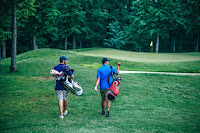 The dog days of summer have arrived and, if you are as passionate about the sport as I am, you will be out on the golf course no matter how hot it gets!
The dog days of summer have arrived and, if you are as passionate about the sport as I am, you will be out on the golf course no matter how hot it gets!Whether you are a beginner to the game or a die-hard amateur, you need to remember to bring the essentials with you so that the round doesn't become a harrowing experience.
Golf for Beginners has compiled are a few tips for playing golf in the summer heat. Review this checklist before your next round:
1. Hydrate! Freeze a bottle of water - it will usually last for the round.
2. Stash extra gloves for perspiration.
3. Sunscreen: How many times have you gotten beet red because you forgot to apply SPF?
Consumer Reports advises sun worshippers to apply sunscreen before bug spray, letting it absorb into the skin and then spray on a separate bug killer - try not to use a combination spray as you will need to reapply the sunscreen but not necessarily the bug spray.
4. Bug Spray: There is nothing worse than a swarming bunch of no-see-ums pinching at your skin as you are trying to make your 150-yard approach shot to the green. Look for a sunscreen that provides you with enough protection so that you are not constantly reapplying it.
5. Sunglasses: Blinding sunlight can have an impact on your eyes, causing blurriness - even if you take them off to look at the dimples on your golf ball, put them back on when walking or riding around in the golf cart.
6. Face towel - place a frozen, wet towel in a baggie and wipe down your face often. When the towel gets warm, refresh with ice at the turn.
7. Hat: Always bring along a hat with visor - the hat protects your skin and the visor protects your eyes.
8. Golf Clothing: Wear moisture-wicking materials which breathe and stay away from black and dark colors as they absorb heat (basic science - white and lighter colors reflect light and heat, dark colors absorb heat).
9. Find Shade: When you are waiting for your turn at the tee box, find a spot of shade to stand in - you will be amazed at how cool you are when approaching your shot.
10. Try for an early morning tee time. It's cooler during AM hours, so why not have an early morning cup of joe and enjoy the sunrise!
Have a golf tip you would like to add to our list of summer heat quenchers? List it in the comments section of this golf blog or tag us on Twitter @Golf4Beginners.



